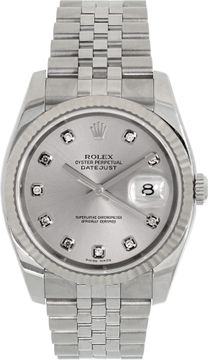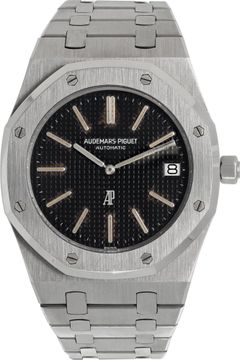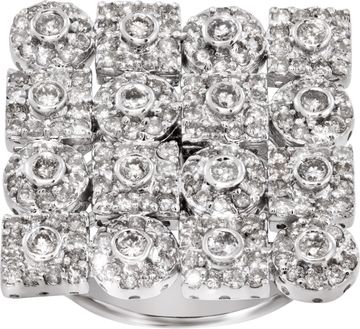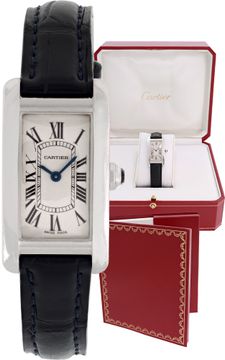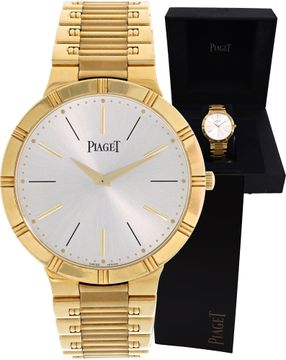Understanding The Type of Watch Movements: Quartz vs Automatic Watch
For watch enthusiasts and casual wearers alike, understanding the inner workings of timepieces can enhance appreciation for these intricate devices. At the heart of every watch lies its movement, the mechanism responsible for keeping time. Two main types dominate the watch world: quartz and mechanical movements. Each has its own set of characteristics, advantages, and drawbacks. Let's dive into the world of watch movements to explore the differences between quartz watches and automatic watches.

Image Link: https://www.grayandsons.com/w525999-patek-philippe-aquanaut-38mm-5065/
Quartz Watch Movements: The Modern Timekeepers
The first quartz watches revolutionized the industry when they were introduced in the late 1960s. These electronic movements use a battery to send an electrical current through a small quartz crystal, causing it to vibrate at a precise frequency. This vibration is then converted into regular electronic pulses that drive the watch's hands.
Key features of quartz movements:
1. Accuracy: Quartz watches are incredibly precise, typically losing or gaining only a few seconds per month.
2. Low maintenance: They require minimal upkeep beyond battery replacements every few years.
3. Affordability: Quartz movements are generally less expensive to produce, making them more accessible to a wider range of consumers.
4. Durability: With fewer moving parts, quartz watches are often more resistant to shock and vibration.
5. Variety: Quartz movements can power a wide range of complications and display types, from simple three-hand watches to complex chronographs and digital displays.
While quartz watches dominate the market in terms of volume, they are often considered less "prestigious" by enthusiasts due to their mass-produced nature and lack of traditional craftsmanship.

Image Link: https://www.grayandsons.com/w528305-rolex-oyster-quartz-36mm-17013/
Mechanical Watch Movements: The Art of Horology
Mechanical watches predate quartz technology by centuries. These intricate machines use a complex system of gears, springs, and other components to keep time. Mechanical movements come in two main varieties: manual-wind and automatic.
Manual-wind movements require the wearer to periodically wind the mainspring by turning the crown. Automatic (or self-winding) movements use the natural motion of the wearer's wrist to wind the mainspring via a rotating weight called a rotor.
Automatic watches, first invented in the 1920s, represent a significant evolution in mechanical watchmaking. These ingenious timepieces harness the kinetic energy from the wearer's everyday movements to keep the watch wound. The key component is the rotor that spins, a metal weight that can freely rotate 360 degrees. As the wearer moves their arm, the rotor spins, winding the series of gears.
This continuous winding process ensures that the watch maintains power as long as it's worn regularly, eliminating the need for daily manual winding. However, if an automatic watch is left unworn for an extended period, it will eventually stop and require manual winding or simply wearing to start again. Many enthusiasts appreciate automatic movements for their convenience and the satisfaction of knowing that their own motion powers their timepiece.
Key features of mechanical movements:
1. Craftsmanship: Mechanical watches are often viewed as works of art, with skilled watchmakers assembling hundreds of tiny components by hand.
2. Heritage: These movements represent centuries of horological tradition and innovation.
3. Smooth operation: The seconds hand in a mechanical watch typically moves in a smooth, sweeping motion rather than the ticking of a quartz watch.
4. Longevity: With proper care, a mechanical watch can last for generations.
5. Complexity: Mechanical movements can incorporate a wide range of complications, from simple date displays to intricate perpetual calendars and tourbillons.
However, mechanical watches do have some drawbacks. They are generally less accurate than quartz watches, more expensive to produce, and require regular servicing to maintain optimal performance.

Image Link: https://www.grayandsons.com/w527667-patek-philippe-aquanaut-36mm-5065/
Comparing Quartz vs Mechanical and Automatic Watch Movements
Accuracy:
Quartz watches are the clear winners in terms of accuracy. A typical quartz watch might lose or gain 15-30 seconds per month, while even high-end mechanical watches may deviate by several seconds a day. For those who prioritize precise timekeeping, quartz is the way to go.
Maintenance:
Quartz watches require little maintenance beyond battery changes every few years. Mechanical watches, on the other hand, need regular servicing (typically every 3-5 years) to clean, lubricate, and adjust the movement. This ongoing maintenance adds to the overall cost of ownership for mechanical timepieces.
Power source:
Quartz powered watches rely on batteries, which need to be replaced every few years. Mechanical watches are powered by the mainspring, which stores energy either from manual winding or, in the case of automatics, from the motion of the wearer's wrist.
Durability:
While both types can be built to withstand everyday wear, quartz movements generally have an edge in durability due to their simpler construction and fewer moving parts. However, high-end mechanical watches often feature robust designs and materials that can withstand significant abuse.
Aesthetics:
This is largely subjective, but many enthusiasts prefer the smooth sweep of a mechanical watch's seconds hand to the ticking motion of a quartz watch. Additionally, mechanical watches often feature exhibition case backs that allow the wearer to admire the intricate movement inside.
Cost:
Quartz watches are generally less expensive due to simpler production processes and lower material costs. Mechanical watches, especially those from luxury brands, can command much higher prices due to the craftsmanship involved and the prestige associated with traditional watchmaking.
Emotional appeal:
Many enthusiasts are drawn to the romance and heritage of mechanical watches. The idea of wearing a tiny machine on the wrist, powered by springs and gears, holds a certain allure that electronic quartz movements can't match.

Image Link: https://www.grayandsons.com/w528307-patek-philippe-twenty-4-30mm-491010a/
Choosing Between Quartz and Mechanical
The choice between a quartz and mechanical luxury watch ultimately comes down to personal preference, budget, and intended use. Here are some factors to consider:
1. If accuracy and low maintenance are your top priorities, a quartz watch is likely the better choice.
2. For those who appreciate traditional craftsmanship and are willing to invest in regular maintenance, a mechanical watch can be a rewarding purchase.
3. If you're drawn to the idea of owning a piece of horological history, mechanical watches offer a stronger connection to watchmaking traditions.
4. For everyday, worry-free wear, especially in demanding environments, a quartz watch might be more practical.
5. If you're on a tight budget but still want a reliable timepiece, quartz watches offer excellent value.
6. For collectors and enthusiasts, both quartz and mechanical watches can have a place in a well-rounded collection, each appreciated for its unique qualities.

Image Link: https://www.grayandsons.com/w528154-unused-audemars-piguet-royal-oak-tour/
In conclusion, both quartz and mechanical movements have their place in the world of watches. Quartz movements offer unbeatable accuracy and convenience, while mechanical movements represent the pinnacle of traditional watchmaking skill. By understanding the differences between these two types of movements, you can make a more informed decision when choosing your next timepiece, whether it's a practical daily wearer or a cherished addition to your collection.
Selling a luxury watch can be a rewarding experience if done correctly. By understanding the value of your watch, choosing the right selling method, preparing your watch for sale, and marketing it effectively, you can ensure a smooth and profitable transaction. At Gray and Sons Jewelers, we offer a trusted and professional consignment service to help you get the best value for your luxury watch. Additionally, our sister company, Sell Us Your Jewelry, provides a convenient and reliable alternative for those looking to sell their watches quickly and securely. Contact us today to learn more about how we can assist you in selling your watch.
Discover Exquisite Pre-owned Luxury Watches and Jewelry: New Arrivals for August 6, 2024
NEXT ARTICLE
Exclusive Pre-owned Luxury: New Arrivals from Tiffany & Co, Rolex, and More - August 5, 2024

